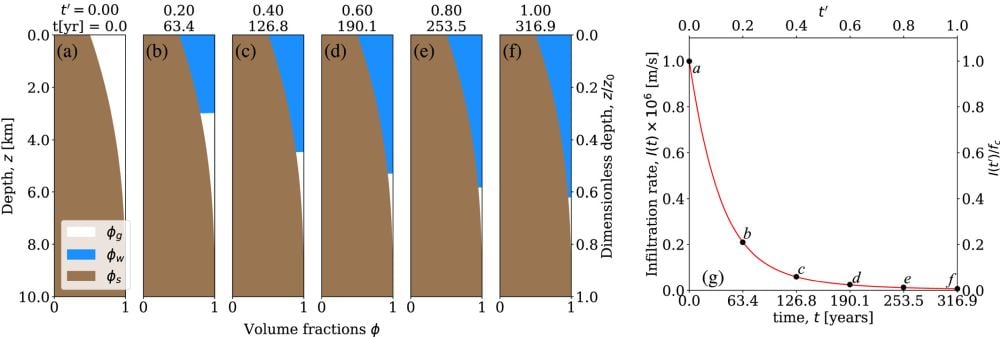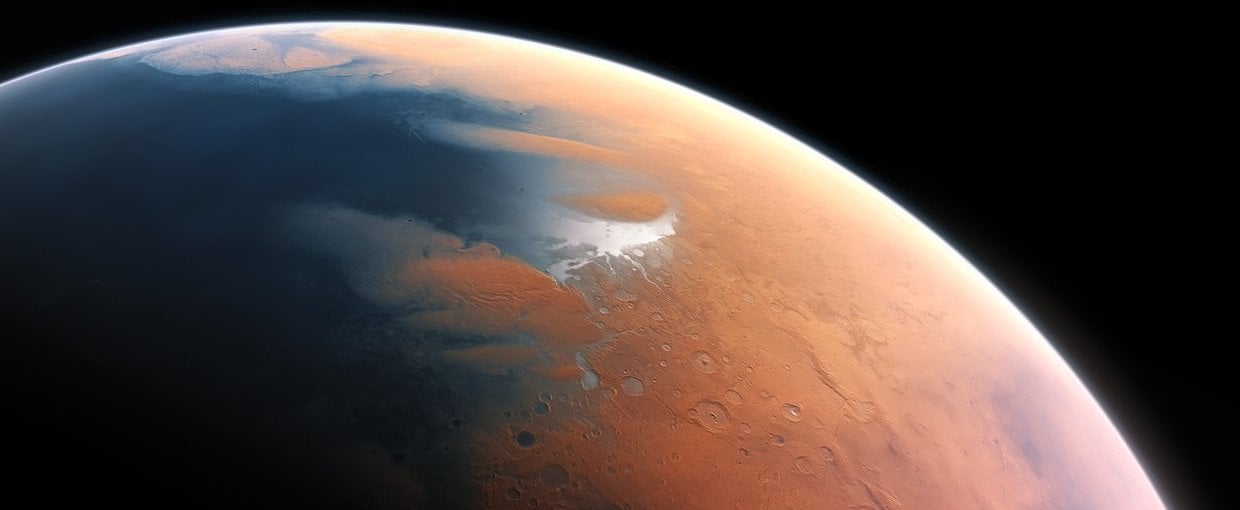Mars' oceans, lakes, and rivers are long gone. They've left behind evidence of their time here in river channels, deltas, paleolakes, and other features. The water's existence isn't a mystery, but its whereabouts are. Did it disappear into space, or did it retreat into underground aquifers?
One way to answer that question is to determine the nature of Mars' hydrological cycle. Like Earth, some of Mars' water would have been, and still may be, sequestered in underground formations. Previous research has assumed that the water infiltrates these aquifers at a static rate. That would lead to certain conclusions about the fate of the water. However, new research examined the infiltration rate, finding that it varied. Does this help explain what happened to Mars' ancient water?
The research, "Infiltration Dynamics on Early Mars: Geomorphic, Climatic, and Water Storage Implications," is published in Geophysical Research Letters. The lead author is Mohammad Afzal Shadab, a postdoctoral researcher at Princeton University.
"To gain insight into the integrated hydrological cycle of early Mars, we chose to focus on infiltration rates into the shallow and deep Martian crust," the authors write.
When precipitation falls as rain, it faces two fates: either it runs across the surface of Mars or infiltrates below it. The division between the two determines how quickly aquifers can be recharged, which changes our understanding of Mars' early hydrological cycle. Precipitation rates are at the base of infiltration, but precipitation rates are determined by global climate models, which the authors say are outside the scope of this research.
Mars' water table is about one mile underground, significantly deeper than Earth's. Mars' crust is more uniform than Earth's because Earth has plate tectonics that continually recycles the crust. The red planet's crust has some heterogeneity due to volcanism, and there's a fundamental dichotomy between the northern lowlands and southern highlands. The southern hemisphere has a much thicker crust than the northern hemisphere.
Taking these and other factors into account, the researchers developed a computer model of Mars focusing on how long it takes water to percolate into the planet's aquifers.
They discovered that water on Mars takes longer to find its way from the surface into aquifers than it does on Earth. While it only takes days here on Earth, on Mars it can take between 50 and 200 years. That slow intrusion rate means water could've covered Mars with at least 100 meters of water.
 This figure illustrates how long it takes for water to infiltrate 10km deep into the Martian crust. The brown, white, and blue regions represent regolith, water, and gas in different volume fractions. The panel on the right shows the corresponding infiltration rate for each volume fraction (a through f). Image Credit: Shadab et al. 2025, Geophysical Research Letters.
This figure illustrates how long it takes for water to infiltrate 10km deep into the Martian crust. The brown, white, and blue regions represent regolith, water, and gas in different volume fractions. The panel on the right shows the corresponding infiltration rate for each volume fraction (a through f). Image Credit: Shadab et al. 2025, Geophysical Research Letters.
Much of the results stem from porosity and permeability, which decay with depth. Models show that the recharge rate slows as the wetting front percolates downward. "This diminishing infiltration rate would enhance surface runoff that is unaccounted for, leading to inaccuracies in land evolution models," the authors write. "Downward percolation implies that the depth of the groundwater table below the topography also becomes an important variable in an integrated hydrological cycle on early Mars."
"We want to implement this into [an integrated model] of how the water and land evolved together over millions of years to the present state," said lead author Shadab in a press release. "That will bring us very close to answering what happened to the water on Mars."
 This figure shows water infiltration rates in two scenarios. The top panel is for a homogeneous crust with uniform hydraulic conductivity; the bottom panel is for a heterogeneous crust with power-law decay in porosity and permeability. Warmer colours represent faster infiltration rates close to 50 years, while the coldest colour represents a 200-year timeframe. Image Credit: Shadab et al. 2025, Geophysical Research Letters.
This figure shows water infiltration rates in two scenarios. The top panel is for a homogeneous crust with uniform hydraulic conductivity; the bottom panel is for a heterogeneous crust with power-law decay in porosity and permeability. Warmer colours represent faster infiltration rates close to 50 years, while the coldest colour represents a 200-year timeframe. Image Credit: Shadab et al. 2025, Geophysical Research Letters.
These results show that ancient Mars' water cycle stubbornly held onto subsurface water and that surface water would've been short-lived because it couldn't be replaced. It also shows that bodies of water like paleolakes would've lost water to the crust more than to the atmosphere. "Paleolakes within basins would have lost water to the subsurface orders of magnitude faster than losses to the atmosphere through evaporation," the authors write.
The way I think about early Mars is that any surface water you had — any oceans or large standing lakes — were very ephemeral," said study co-author Eric Hiatt from the University of Texas at Austin. "Once water got into the ground on Mars, it was as good as gone. That water was never coming back out.
The results aren't bad for potential habitability regarding modern Mars. They show that while Mars' surface became dry, cold, and inhospitable, its water wasn't all lost to space. Instead, large quantities are stubbornly sequestered underground. It's also good news for our descendants, who will need to find water for any sustained presence on the planet.
Recent research shows that Mars may have had multiple, distinct periods of abundant surface water. The Curiosity rover in Gale Crater found three distinct periods of lake formation, each with different water chemistry. If near-surface infiltration was rapid, while crustal infiltration took decades, as this work shows, the surface and subsurface water systems weren't in temporal equilibrium. This could help explain the multiple wet periods and some of the contradictions in Mars' geological record. For example, climate models have difficulties producing temperatures warm enough for persistent surface water under early Mars'faint young sun conditions, yet geological evidence clearly shows abundant fluvial features.
The planet's multiple wet periods and this new research add to the complexity and the mystery surrounding ancient Mars and its water. The research will also feed into a more detailed study of the planet's past.
"Future work, including dynamic infiltration in groundwater and land evolution models, will help quantify the convolved effects of water partitioning in the climate system and the integrated hydrological cycle of early Mars," the authors conclude.
 Universe Today
Universe Today
